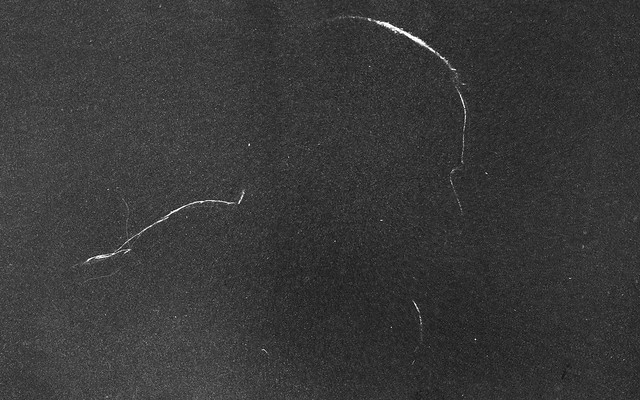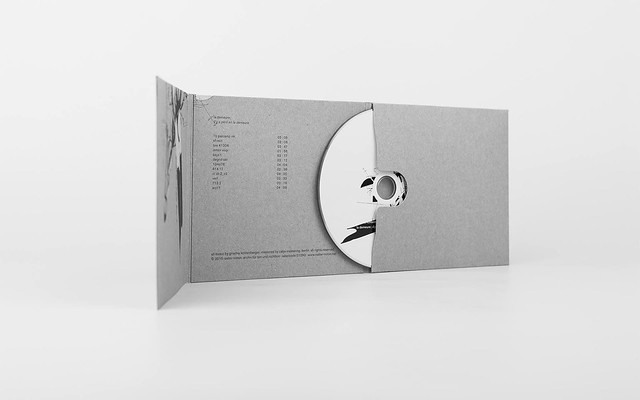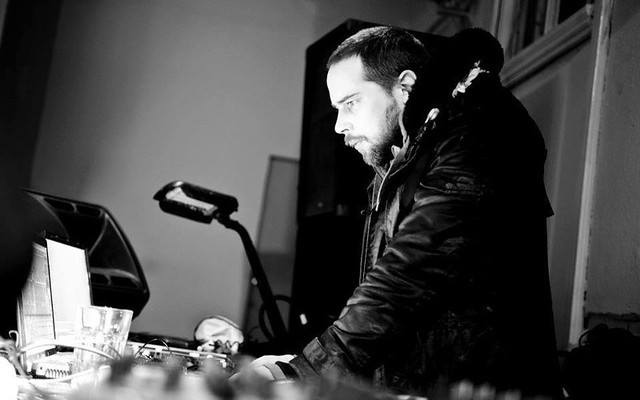The Other // Grischa Lichtenberger

Photo Credit: Madison Dinelle, 2014
Despite his fairly concise release history, Grischa Lichtenberger is an artist who somewhat defines Carsten Nicolai's Raster-Noton imprint for me. His work is both intriguing and beguiling in equal measure, feeling as much about process as it is results. Having been brought up in Bielefeld, Lichtenberger’s compositions are often referenced in the context of artists like Autechre or Aphex Twin, yet have a sense of being developed in isolation, without too much care for what is popular in the wider world of electronic music.
With his most recent LP, La Demeure; il y a péril en la demeure having been released recently and a following EP to follow shortly, we decided to catch up with Lichtenberger to discuss the composition of the album, working with Raster-Noton, and the benefits and shortcomings of social networking. Much like his releases, Lichtenberger's answers beg as many questions as they answer.
Hi Grischa, so first off how are things? You put out 'La Demeure; il y a peril en la demeure' recently, your first album in three years. I was reading this piece of text by you where you reference the two concepts - can you tell us a bit more about their translation and why you chose them as a reference point for the album?
The titles for my albums are less conceptual, pre-thought ideas, but more sentences which are strangely attracting to me, in which all the things that have happened during the process of production return to. It's like I’m weaving a web, but in the end, I never find a way to recall the paths of all the strings, yet I still have the feeling that it holds together somehow.
In a way this is pretty much in line with the ideas that grew under the title 'La Demeure; il y a péril en la demeure’: at its core it is a discussion about historic elements that could never be told thoroughly. La Demeure translates as the shelter, the den, the home. A retreat, withdrawal, but also a safe haven, a refuge. Some sort of special empowering place in the world, a dwelling. It is a term I first encountered while reading Emmanuel Levinas' 'Totality and Infinity' a few years ago. The book is separated into two parts; in the first he develops a notion of 'the other' as a transcendent force that precedes any ontological construction. That means that for Levinas, an encounter with the other is a metaphysical notion that excels any immanent theoretical elaboration. If the theory forgets about this dependency it arouses the suspicion to suppress, thus being comparable with political totalitarianism. It would become a theory that forgets about the past lying beyond it's own restrictions. Levinas' experience as a Jew in WWII conflicts heavily with Heidegger’s ontology, not only because of the direct associations between him and the Nazis, but on a deeper level, because of a heroistic and thus egoistic concept of self empowerment (Selbstergreifung des Daseins) that excludes the role of the other completely. For Heidegger the home, the house, the homeland (heimat); all these mythological flesh-and-blood relationships are of great importance and leads him close to the neo-theological concepts of heritage and race in German fascism. They serve him as a retreat from the other, as a solicitad island of reflection and contemplation (Einkehr).
In the beginning of the second part of Levinas' book he develops a different concept of the home, or the dwelling (as it is translated). Very much bound to the ethics of 'the other', the home is no longer the somewhat grim, obdurate encounter with the other as a transcendent metaphysical force (as in the first part of the book), but an encounter of friendship (Heidegger stays quite voiceless on the matter of the fellow human being, the Mitmensch). For Levinas it is of great importance that there is this mercy of 'the other' - who gives shelter, who provides, cares and caresses the ego.
For me it made sense to connect these ethical dimensions to art. There is something uneconomical in the communicative exchanges art provides. Apparently some things are shared that are not reducible to immediate consumption. This is I think, closely connected to this trace of 'the other'. For me the question of the so-called 'inner motivation' for making art was a massive grey area. Sometimes the motivation is explained as the simple necessity of a genius - someone who seems to be unexplainably good at something and just 'needs' to become an artist or it is explained as a somewhat pathological passion. There seems to be something in art that exiles the behaviour of the artist from the normal functions of living. The exile, that provides the artist with these 'special' abilities to trigger communication with non-explicable aspects, was for me always closely related to something quite intimate. It is like a traces of memories or ghosts that build an ethical vessel sustaining the art on it's uneconomical side, and the demeure-figure triggered that idea perfectly.
I then came to realise that this intimacy maybe focuses too much on production and less on communication (an identification and reflection of the artist, but not of the art). There is this tension between illustration and illusion so that this exile is building up a crisis. Art can be stupid and meaningful at the same time. That’s where the second part, the saying ' il y a péril en la demeure' comes into play. The juristicial term translates in English to ‘exigent circumstances’. The peril, the danger, the crime that is going on in the dwelling, in the private area, makes it necessary for a public entity to intrude, to secure, to save. It is also related to saving evidence (as the evidence of the critical struggle inside the intimate exile of art) as it connects to saving the exiled entity itself from being sucked away by the peril it is entangled in.
How does the album's artwork tie into this as well? Was this something you designed yourself?
The origins of the series' artwork are some drawings I made last year. Drawing is a sort of thought-process for me, where you would not only drill a hole in the problem that is before you, but you would mark the space surrounding it. So I could not really say, this is an illustration or a map of this and that (of the demeure), but the drawing is concerned with these ideas and the proceedings of the drawing itself tell something about the problem. I also had the feeling that, while I was always looking for a connection between the different mediums I’m using (music and painting, installations and texts), drawing actually showed something of every different media, and aesthetically, worked well with the music.

When it came to converting these into the finished album design, Olaf Bender from Raster Noton helped a lot. It was his idea to use this simple cardboard box as a case to underline a certain roughness and forwardness in the material, and he also found time to arrange the printing and the typography (which I really suck at).
Going back to the title, your albums seem to have very strong themes laid out for them - and IV (inertia) refers to 'a fictionalized successor of the baksan neutrino telescope in the caucasus region' and this new series focuses on the 'La Demeure' and 'il y a peril en la demeure' concepts. By contrast however, you have stated previously that you aren't keen to name your tracks as doing so would pre-define the listeners experience of them. Is the idea then to make the listener consider the work as a whole rather than to focus in on individual tracks?
Hmm, maybe. Interesting how this spells an incoherence for you. No, honestly I am not sure about that. I think the themes (like '~Treibgut' or Andyrchie IV or now, La Demeure) work for me as larger containers, in which a whole bunch of things find their place (all of my artwork in this certain 'period' are gathered under these themes, not only the albums), while the track titles (as they are mostly dates or refer to other organisational elements) have a practical meaning for me. The connection between the larger container and the things arranged under them needs to stay a bit loose for me - I don't want to illustrate an idea with them. At the same time I hope that the titles of the album don't impose a certain understanding on the tracks, of course this must happen to a certain degree, but I hope they work in a more open way than as a strict reduction.
I like the aspect of thinking about the "work as a whole", as you said, and maybe the reason really lies there. I have something to say that is inexplicable other than in the form they appear (music, writing, visual etc), but to organize them, to hold them together, needs thinking about for me. A reflection that says: "it's worth doing it because of this and that reason", and that is the organisation provided by these different themes. I couldn't just say 'well this was 2013 and that's it'. I don't think it's self-explanatory to do these things at all (while there is a destructive criticism lurking around in me), so I’m constantly reinterpreting myself, thinking about the legitimization. Why do I like this thing I made and not another thing? Each track also has what I call 'strategies' applied to it that are sometimes marked in their titles. For instance, ‘Degrid Skt’ is a notation of a grid-less sequencing process, 'B Palcamp Rm' involves a parallel compression process, while '614 12' is simply a track from the 12th June 2014.
I was looking at some of the visual pieces on your Vimeo account which seem to blend raw filming with electronic manipulations - much as your music does. What do you think it is about the contrast between these two things you find so interesting?
I always liked a certain materiality with things: stuff, fabric, matter. I grew up with Joseph Beuys' fetishism of fat and felt and all that stuff. At the same time I loved recording things, collecting and gathering - just as digital systems can do so easily today - collect data and make it reappear on command. I guess what is interesting for me in combining them is to have them collide - the material as a trace of memory, when you collect and record it and then manipulate the digital recordings so that you have a sort of changed substance. But maybe it is something even more psychologically determined - the workshop of my father always provided the best instruments to play with, so it seems quite natural to play with the tools, not only the matter itself.
On another note I think this connection is especially interesting in present times. You have huge amounts of data, but less and less memorable things - I guess the interest in this collision of the physical and this elusive 'digital-ness' is also a concerned resistance or at least a troubled product of this problem.

One thing that has struck me listening to your mixes is the breadth of genres you feature in them. Would you say the selections you make in your mixes are generally representative of your listening tastes? I read you listened to a lot of guitar based music growing up - what was the first music you really fell in love with?
I’m not sure how to answer this. There have been washing machines that sounded quite primordial; there was Beethoven, there was Bad Religion and Nirvana, then Radiohead and June 44, then Tortoise and Autechre. I don't know, I can't really draw the line and say this was the most important, the first thing. They all stand out in a certain way - but the guitar music of the '90s - Grunge and the local post-hardcore scene in Bielefeld which my brother was involved in, had a very important influence on how I understood the emotion of music and the production means, as home-recording was really elementary for all the small bands coming up around that time. This, for instance is a band my brother played drums in for some time, i still love to listen to this stuff from time to time.
In your Electronic Beats article you mention using Myspace a lot and enjoying it as a creative space to share ideas. Do you think something has been lost in the thrill of those early communication/music sharing platforms? If so, why do you think that is? Why do platforms like Facebook fall short?
Well, I guess for me, when Myspace, Studivz and Flickr began, I had the desire to connect, to reach out to someone. The idea was that the people on these platforms could maybe understand what you were up to better than the people next to you on the subway. Now I think there is certain problem with these platforms, marking you as being disconnected if you are not part of them. While they still have the potential to actually connect people with each other, they also seem to increasingly focus on the idea of you being connected to them as well. Also, because of the large amounts of people and data, things tend to get lost. I guess I’m just too old now to get the idea of Twitter and the Facebook timeline, where everything is constantly swept away. You would need a super pretentious 'my life is my art' attitude to generate enough attention to be seen. While I do think my life is part of my art, I don't like this idea of pushing yourself to actually become a painting.
You also mention that Carsten Nicolai first contacted you using Myspace - Can you remember the first time you met in person? What was that like having only communicated online beforehand?
Well, at first I received an email, asking for a demo... I just couldn't believe it and thought someone was playing with me. The trust the people from Raster-Noton put in me is still difficult to comprehend for me and feels very much like unjustifiable luck. But over the years I have had some really nice, trust provoking encounters with them, meaning I consider them friends in a way. It stays in this double-bind, which is the same with all the friends I have - something unreal in the sheer luck that someone you like, likes you back.
Anyway I remember playing in Rome at 'Electric Campfire' some years ago (the first time I ever played a live set) and Carsten (Nicolai) came over at the beginning and raised the volume on the desk saying: "this needs to be louder."
Do you feel more creatively free working with Raster-Noton than with others?
I certainly feel that I have an understanding with them - that this music-thing is not a solitary island of clubs, genres and styles, but a form of artistic expression. It is the bigger picture that makes my work more legit in spite of the fact I am not a trained musician.
Finally what's next for you? What can we expect from the next instalment of the 'La Demeure' series?
Next is the Spielraum EP on vinyl - I am very much looking forward to its release. The tracks on it evolved very fast (in comparison to the large amounts of time I needed to compose the album) and they have a certain directness to them I really enjoy. I hope you might as well.
The Spielraum EP will be released on Raster-Noton in December.
- Published
- Nov 25, 2015
- Credits
- Words by Theo Darton-Moore
.jpg)